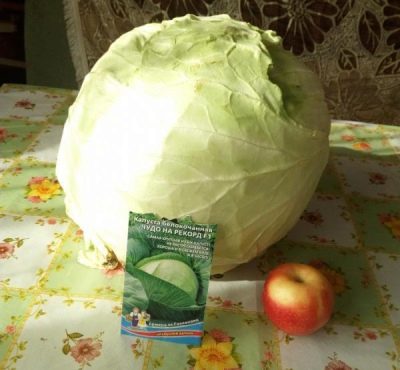
- Authors: Holland
- Appointment: for fresh consumption, for fermentation
- Weight, kg: up to 17
- Yield: high
- Growing regions: it is necessary to fertilize with mineral fertilizers
- Ripening terms: mid-season
- The period from germination to technical ripeness: 122 days
- The form: rounded flat
- Disease and pest resistance: resistant to major diseases of cabbage
- Resistant to head cracking: stable
Thanks to the development of breeders, varieties of cabbage have been created that are able to grow and give high yields even in unfavorable climates, as well as in areas with risky farming. These include the Miracle white cabbage on a Dutch breeding record.
Description of the variety
Miracle Record is a first generation hybrid bred by Dutch breeders in 2016. The vegetable is cultivated mainly in open ground: garden ridges, fields, farmlands. Despite the fact that the vegetable has appeared quite recently, its popularity is growing rapidly. Today, Miracle cabbage for a record is grown in the Central region, in Siberia, as well as in Altai.
Characteristics of the appearance of the plant and heads of cabbage
White cabbage is a large plant with a raised rosette of leaves. The diameter of the plant reaches 100 cm. The vegetable crop is characterized by large elongated leaves, evenly covered with a gray-green color. Foliage venation is weak. In addition, a wax coating is noticeable on the surface of the leaf plates, and their edges are slightly wavy.
Cabbage Miracle on the record ripens neat, the same shape. The hybrid belongs to large-fruited. The average weight of a head of cabbage is 8-17 kg. Sometimes larger heads ripen - up to 20-21 kg. The heads of cabbage are flat-round. The structure is quite dense. Externally, the vegetable has a green color with a bluish tint, and in the cut (inside) the pulp is light or creamy white. Cabbage stumps are powerful, of medium length, but, despite this, the outer stump sometimes breaks due to the severity of the cabbage head.
Ripe cabbage heads easily transfer long-distance transportation. The advantage of the hybrid is its good keeping quality, the duration of which is 5-6 months without loss of taste and marketability.
Purpose and taste
Cabbage Miracle on record impresses not only with its dimensions, but also with its taste. Cabbage pulp is characterized by moderate juiciness and meatiness without fibrillation and wateriness. The taste contains light sweetness, tenderness and a pleasant classic aroma. The crunch of the leaves persists even with prolonged storage of the vegetable.
Ripe heads of cabbage are widely used in cooking: cabbage is pickled, fermented, added to hot and cold dishes, and also grown for winter preparations.
Ripening terms
The hybrid belongs to the mid-season varieties. The growing season lasts 122 days. It takes only 80-85 days from planting seedlings in the garden to ripening of cabbage heads. Heads of cabbage ripen gradually, so the harvest period is somewhat extended - from late August to October.
Yield
The yield of the hybrid is excellent. With proper care, up to 20 kg of crispy vegetables can be cut from 1 m2 of plantings.
Growing and care
Cabbage is cultivated by seedling and seed methods. In regions with a cool and unstable climate, it is better to use the seedling method. To do this, sowing seeds for seedlings is carried out in late March - early April.Bushes aged 40-45 days with a height of 16-20 cm and 4-5 true leaves are suitable for transplanting to a permanent place of growth. Seedlings are planted at the end of May, when the soil and air are well warmed up. For planting, use the standard scheme of 60x60 cm.
The agricultural technology of vegetable crops includes basic measures: watering with settled water every 3-4 days, especially during the formation of heads of cabbage, applying dressings 3-4 times per season (the vegetable responds well to mineral fertilizers), weeding and loosening the soil, hilling plants (once enough ), prevention of diseases and insect infestations. It is important to remember that it is recommended to completely stop watering 2-3 weeks before cutting the cabbage heads.

To grow a rich cabbage crop, you need to know when and how to plant this crop outdoors. Planting dates are determined depending on the variety. It is also necessary to properly prepare the soil and follow the rules of crop rotation.


Soil requirements
Cabbage grows comfortably in loose, breathable, nutritious and moist soils with low or neutral acidity. The vegetable reacts negatively to heavy and swampy soils.

Cabbage requires particularly careful care when growing. The plant quickly absorbs nutrients, so the soil needs to be enriched regularly. Adequate amounts of minerals, organics and nitrogen must be provided. Some products can be purchased at the store, while others are easy to make at home.
Required climatic conditions
Vegetable culture Miracle for a record has excellent stress resistance, providing protection from temperature fluctuations, sudden cold snaps and short drought. It is recommended to plant cabbage in sunny areas, where it is light and warm throughout the day.
Disease and pest resistance
Good immunity protects the plant against many bacterial diseases. Cabbage is resistant to fusarium wilt and bacteriosis. Sometimes the vegetable is attacked by pests: aphids, a bear, a cabbage bug, a scoop, a moth, a hidden proboscis and a dark nutcracker. Timely spraying with insecticidal preparations helps to fight insects.

Cabbage is a very popular horticultural crop. But growing a good, large and tasty cabbage is sometimes very difficult, because it is often affected by a huge number of diseases and pests. The main role in the cultivation of this vegetable is played by regular prevention, which helps to get a rich harvest, and prevent the occurrence of diseases and the invasion of harmful insects. It is very important to start treatment as early as possible, otherwise there is a risk of spreading the infection to still unaffected plants.























































































